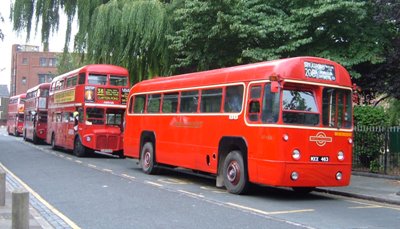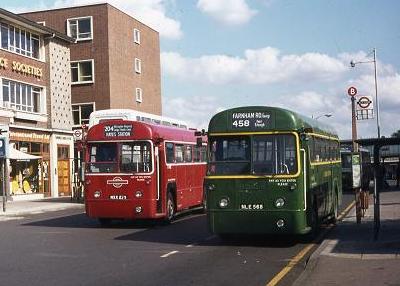 The RF Story The RF Story
London Transport's AEC Regal IV
single-decker
A preserved example of the
red RF, dating from 1953. A family resemblance between the RF
(first built 1951) and the Routemaster (first built 1954) can be
seen, but the increased height of the RF saloon, caused by the
underfloor engine, is clear. The similarity is not a
coincidence - the RF body was designed by consultant Douglas Scott,
who also 'was largely responsible for the shape and decor of the
Routemaster' (Ken Blacker).
RF486 ran over route 208A (which ended in 1959, and which
it had worked in 1956/7 when based at Dalston) on 21 July 2005, and is seen here on the
old stand at Clapton Pond, three months before the last
Routemasters operated route 38 on 28
October.
Photo © Peter
Osborn
The RF was the standard single-decker in the London Transport
fleet in the 1950s and 1960s, before replacement by modern, mostly
rear-engined buses. The AEC design incorporated an engine
under the floor, a pre-war idea that reached its peak in this
fleet. The same design was used for coaches and buses, both
red and green, with detailed differences.
 The RF story is told in the following
pages, arranged as follows:
·
Diversity - the use of a standard design
for different purposes
·
Into service - the 1950s
·
Rejuvenation - OMO and other changes
·
Maturity - 1960s and 1970s
Appendices:
We are indebted to many sources for the information used, see
the Bibliography. See also the
Red RF memories of crews and
passengers.
Red met green (and Green
Line) at Uxbridge, amongst other places. Late in the RF
story, Uxbridge RF391 on the 204 passes
London Country Windsor's RF568 on the 458, one of the last few
country RF routes. A modernised Green Line RF on London
Country route 457 A is behind.
Other parts of this site concentrate on the Central Area
buses. Details of the routes worked by red RFs are in the
Routes section, with some general
background to London Transport operations here.
|